Analysis of Groundwater Storage at The Local Scale in the Missan Region, Iraq, Based on GRACE Satellite and Well Data
Abstract
1. Introduction
2. Materials and Methods
2.1. Study Area
2.2. Data Sources
2.3. Methodology
- A machine learning approach utilizing these items:
- Stratified sampling of GRACE’s TWS values.
- Random Forest regression trained on FLDAS predictors:
- Soil moisture profiles four layers, precipitation, SWE, and land cover classification.
3. Results and Discussion
Uncertainty Analysis
4. Conclusions
5. Recommendations
Author Contributions
Funding
Data Availability Statement
Conflicts of Interest
References
- AlJumaili, K.K.; Al-Khafaji, M.S.; Al-Awadi, A.T. Assessment of Evapotranspiration Estimation Models for Irrigation Projects in Karbala, Iraq. Eng. Technol. J. 2014, 32, 1149–1157. [Google Scholar] [CrossRef]
- Saeed, F.H.; Al-Khafaji, M.S.; Al-Faraj, F. Hydrologic Response of Arid and Semi-Arid River Basins in Iraq under a Changing Climate. J. Water Clim. Change 2022, 13, 1225–1240. [Google Scholar] [CrossRef]
- Saeed, F.H.; Al-Khafaji, M.S.; Al-Faraj, F.A.M.; Uzomah, V. Sustainable Adaptation Plan in Response to Climate Change and Population Growth in the Iraqi Part of Tigris River Basin. Sustainability 2024, 16, 2676. [Google Scholar] [CrossRef]
- Mohamed, A.; Alarifi, S.S.; Mohammed, M.A.A. Geophysical Monitoring of the Groundwater Resources in the Southern Arabian Peninsula Using Satellite Gravity Data. Alex. Eng. J. 2024, 86, 311–326. [Google Scholar] [CrossRef]
- Aziz, N.A.; Alwan, I.A. An Accuracy Analysis Comparison of Supervised Classification Methods for Mapping Land Cover Using Sentinel 2 Images in the Al-Hawizeh Marsh Area, Southern Iraq. Geomat. Environ. Eng. 2021, 15, 5–21. [Google Scholar] [CrossRef]
- Alwan, I.A.; Karim, H.H.; Aziz, N.A. Investigate the Optimum Agricultural Crops Production Seasons in Salah Al-Din Governorate Utilizing Climate Remote Sensing Data and Agro-Climatic Zoning. Iraqi J. Sci. 2019, 60, 2087–2094. [Google Scholar] [CrossRef]
- Brunner, P.; Hendricks Franssen, H.-J.; Kgotlhang, L.; Bauer-Gottwein, P.; Kinzelbach, W. How Can Remote Sensing Contribute in Groundwater Modeling? Hydrogeol. J. 2007, 15, 5–18. [Google Scholar] [CrossRef]
- Thakur, J.K.; Singh, S.K.; Ekanthalu, V.S. Integrating Remote Sensing, Geographic Information Systems and Global Positioning System Techniques with Hydrological Modeling. Appl. Water Sci. 2017, 7, 1595–1608. [Google Scholar] [CrossRef]
- Scanlon, B.R.; Longuevergne, L.; Long, D. Ground Referencing GRACE Satellite Estimates of Groundwater Storage Changes in the California Central Valley, USA. Water Resour. Res. 2012, 48, 1–9. [Google Scholar] [CrossRef]
- Chen, J.; Cazenave, A.; Dahle, C.; Llovel, W.; Panet, I.; Pfeffer, J.; Moreira, L. Applications and Challenges of GRACE and GRACE Follow-on Satellite Gravimetry. Surv. Geophys. 2022, 43, 305–345. [Google Scholar] [CrossRef] [PubMed]
- Condon, L.E.; Kollet, S.; Bierkens, M.F.P.; Fogg, G.E.; Maxwell, R.M.; Hill, M.C.; Fransen, H.H.; Verhoef, A.; Van Loon, A.F.; Sulis, M. Global Groundwater Modeling and Monitoring: Opportunities and Challenges. Water Resour. Res. 2021, 57, e2020WR029500. [Google Scholar] [CrossRef]
- Gleeson, T.; Wagener, T.; Döll, P.; Zipper, S.C.; West, C.; Wada, Y.; Taylor, R.; Scanlon, B.; Rosolem, R.; Rahman, S. GMD Perspective: The Quest to Improve the Evaluation of Groundwater Representation in Continental-to Global-Scale Models. Geosci. Model Dev. 2021, 14, 7545–7571. [Google Scholar] [CrossRef]
- Alghafli, K.; Shi, X.; Sloan, W.; Shamsudduha, M.; Tang, Q.; Sefelnasr, A.; Ebraheem, A.A. Groundwater Recharge Estimation Using In-Situ and GRACE Observations in the Eastern Region of the United Arab Emirates. Sci. Total Environ. 2023, 867, 161489. [Google Scholar] [CrossRef] [PubMed]
- Nannawo, A.S.; Lohani, T.K.; Eshete, A.A. Analyzing Groundwater Storage Anomalies in Data-scarce Areas of Ethiopia’s Rift Valley Basin Using Artificial Neural Network. World Water Policy 2024, 10, 909–939. [Google Scholar] [CrossRef]
- Hatem, I.; Alwan, I.A.; Ziboon, A.R.T.; Kuriqi, A. Assessment of Agricultural Drought in Iraq Employing Landsat and MODIS Imagery. Open Eng. 2024, 14, 20220583. [Google Scholar] [CrossRef]
- Boloorani, A.; Soleimani, M.; Papi, R.; Alavipanah, S.; Fadhil Al-Quraishi, A. Zoning Areas Susceptible to Land Subsidence in Tigris and Euphrates Basins. Eng. Technol. J. 2019, 37, 265–272. [Google Scholar] [CrossRef]
- Fallatah, O.A.; Ahmed, M.; Save, H.; Akanda, A.S. Quantifying Temporal Variations in Water Resources of a Vulnerable Middle Eastern Transboundary Aquifer System. Hydrol. Process. 2017, 31, 4081–4091. [Google Scholar] [CrossRef]
- Rahimzadegan, M.; Entezari, S.A. Performance of the Gravity Recovery and Climate Experiment (GRACE) Method in Monitoring Groundwater-Level Changes in Local-Scale Study Regions within Iran. Hydrogeol. J. 2019, 27, 2497–2509. [Google Scholar] [CrossRef]
- Rateb, A.; Scanlon, B.R.; Pool, D.R.; Sun, A.; Zhang, Z.; Chen, J.; Clark, B.; Faunt, C.C.; Haugh, C.J.; Hill, M. Comparison of Groundwater Storage Changes from GRACE Satellites with Monitoring and Modeling of Major US Aquifers. Water Resour. Res. 2020, 56, e2020WR027556. [Google Scholar] [CrossRef]
- Vishwakarma, B.D.; Devaraju, B.; Sneeuw, N. What Is the Spatial Resolution of Grace Satellite Products for Hydrology? Remote Sens. 2018, 10, 852. [Google Scholar] [CrossRef]
- Becker, M.; LLovel, W.; Cazenave, A.; Güntner, A.; Crétaux, J.-F. Recent Hydrological Behavior of the East African Great Lakes Region Inferred from GRACE, Satellite Altimetry and Rainfall Observations. C. R. Géosci. 2010, 342, 223–233. [Google Scholar] [CrossRef]
- Wang, X.; de Linage, C.; Famiglietti, J.; Zender, C.S. Gravity Recovery and Climate Experiment (GRACE) Detection of Water Storage Changes in the Three Gorges Reservoir of China and Comparison with in Situ Measurements. Water Resour. Res. 2011, 47. [Google Scholar] [CrossRef]
- Ouma, Y.O.; Aballa, D.O.; Marinda, D.O.; Tateishi, R.; Hahn, M. Use of GRACE Time-Variable Data and GLDAS-LSM for Estimating Groundwater Storage Variability at Small Basin Scales: A Case Study of the Nzoia River Basin. Int. J. Remote Sens. 2015, 36, 5707–5736. [Google Scholar] [CrossRef]
- Biancamaria, S.; Mballo, M.; Le Moigne, P.; Sánchez Pérez, J.M.; Espitalier-Noël, G.; Grusson, Y.; Cakir, R.; Häfliger, V.; Barathieu, F.; Trasmonte, M.; et al. Total Water Storage Variability from GRACE Mission and Hydrological Models for a 50,000 km2 Temperate Watershed: The Garonne River Basin (France). J. Hydrol. Reg. Stud. 2019, 24, 100609. [Google Scholar] [CrossRef]
- Liesch, T.; Ohmer, M. Comparison of GRACE Data and Groundwater Levels for the Assessment of Groundwater Depletion in Jordan. Hydrogeol. J. 2016, 24, 1547–1563. [Google Scholar] [CrossRef]
- Rzepecka, Z.; Birylo, M. Groundwater Storage Changes Derived from GRACE and GLDAS on Smaller River Basins—A Case Study in Poland. Geosciences 2020, 10, 124. [Google Scholar] [CrossRef]
- Wiese, D.N.; Landerer, F.W.; Watkins, M.M. Quantifying and Reducing Leakage Errors in the JPL RL05M GRACE Mascon Solution. Water Resour. Res. 2016, 52, 7490–7502. [Google Scholar] [CrossRef]
- Lezzaik, K.; Milewski, A. A Quantitative Assessment of Groundwater Resources in the Middle East and North Africa Region. Hydrogeol. J. 2018, 26, 251–266. [Google Scholar] [CrossRef]
- Eshagh, M.; Fatolazadeh, F.; Goïta, K. Impact of Uncertainty Estimation of Hydrological Models on Spectral Downscaling of GRACE-Based Terrestrial and Groundwater Storage Variation Estimations. Remote Sens. 2023, 15, 3967. [Google Scholar] [CrossRef]
- Shami, S.; Ghorbani, Z. Investigating Water Storage Changes in Iran Using Grace and Chirps Data in the Google Earth Engine System. Int. Arch. Photogramm. Remote Sens. Spat. Inf. Sci. 2019, 42, 981–984. [Google Scholar] [CrossRef]
- Mehdi, A.; Mobin, E.; Mohammad, A.; Elyasi, A.H.; Zahra, N. Application Assessment of GRACE and CHIRPS Data in the Google Earth Engine to Investigate Their Relation with Groundwater Resource Changes (Northwestern Region of Iran). J. Groundw. Sci. Eng. 2021, 9, 102–113. [Google Scholar]
- Magnoni, P.H.J.; Silva, C.d.O.F.; Manzione, R.L. Groundwater Recharge and Water Table Levels Modelling Using Remotely Sensed Data and Cloud-Computing. Sustain. Water Resour. Manag. 2020, 6, 113. [Google Scholar] [CrossRef]
- Pulla, S.T.; Yasarer, H.; Yarbrough, L.D. GRACE Downscaler: A Framework to Develop and Evaluate Downscaling Models for GRACE. Remote Sens. 2023, 15, 2247. [Google Scholar] [CrossRef]
- Mohseni, F.; Ahrari, A.; Haunert, J.-H.; Montzka, C. The Synergies of SMAP Enhanced and MODIS Products in a Random Forest Regression for Estimating 1 Km Soil Moisture over Africa Using Google Earth Engine. Big Earth Data 2024, 8, 33–57. [Google Scholar] [CrossRef]
- Ghalib, H.B.; Söğüt, A.R. Environmental Isotopic Characterization of Groundwater and Surface Water in Northeast Missan Province, South Iraq. Acta Geol. Sin. Ed. 2014, 88, 1227–1238. [Google Scholar] [CrossRef]
- Parsons, R.M. Ground-Water Resources of Iraq, Khanaqin-Jassan Area (Vol. 1); Development Board, Ministry of Development Government of Iraq: Baghdad, Iraq, 1956.
- Muhaisen, N.; Khayyun, T.; Al-Mukhtar, M. Drought Forecasting Model for Future Climate Change Effects in a Regional Catchment Area in Northern Iraq. Eng. Technol. J. 2024, 42, 1–15. [Google Scholar] [CrossRef]
- Kassab, I.I.M.; Abbas, M.J.; Buday, T.; Jassim, S.Z. The Regional Geology of Iraq, Vol. 2, Tectonism, Magmatism and Metamorphism; Geological Survey and Mineral Investigation: Baghdad, Iraq, 1987. [Google Scholar]
- Saleh, S.A.; Al-Ansari, N.; Abdullah, T. Groundwater Hydrology in Iraq. J. Earth Sci. Geotech. Eng. 2020, 10, 155–197. [Google Scholar]
- Al-Shammary, S.H. Hydrogeology of Galal Basin-Wasit East, Iraq. Ph.D. Thesis, Department of Geology, College of Science, University of Wasit, Kut, Iraq, 2006. [Google Scholar]
- Al-Aboodi, A.H.; Al-Kadhimi, A.M.; Al-Tai, M.A. Mathematical Model of Groundwater Flow in Teeb Area, Missan Province, South of iraq. Kufa J. Eng. 2013, 5, 51–70. [Google Scholar] [CrossRef]
- Aziz, N.A.; Hasan, R.H.; Abdulrazzaq, Z.T. Optimum Site Selection for Groundwater Wells Using Integration between GIS and Hydrogeophysical Data. Eng. Technol. J. 2018, 36, 596–602. [Google Scholar] [CrossRef]
- Khalaf, A.G. Determination the SuiTable Locations for Drilling Wells for Irrigation Purpose by Using Geographic Information System (GIS). Eng. Technol. J. 2016, 34, 80–89. [Google Scholar] [CrossRef]
- Available online: https://Earth.Gsfc.Nasa.Gov/Geo/Data/Grace-Mascons (accessed on 16 April 2024).
- Available online: https://Giovanni.Gsfc.Nasa.Gov/Giovanni (accessed on 16 April 2024).
- Tiwari, V.M.; Wahr, J.; Swenson, S. Dwindling Groundwater Resources in Northern India, from Satellite Gravity Observations. Geophys. Res. Lett. 2009, 36, 184–201. [Google Scholar] [CrossRef]
- Müller Schmied, H.; Cáceres, D.; Eisner, S.; Flörke, M.; Herbert, C.; Niemann, C.; Peiris, T.A.; Popat, E.; Portmann, F.T.; Reinecke, R. The Global Water Resources and Use Model WaterGAP v2. 2d: Model Description and Evaluation. Geosci. Model Dev. 2021, 14, 1037–1079. [Google Scholar] [CrossRef]
- Huang, Z.; Pan, Y.; Gong, H.; Yeh, P.J.; Li, X.; Zhou, D.; Zhao, W. Subregional-scale Groundwater Depletion Detected by GRACE for Both Shallow and Deep Aquifers in North China Plain. Geophys. Res. Lett. 2015, 42, 1791–1799. [Google Scholar] [CrossRef]
- Li, B.; Rodell, M.; Kumar, S.; Beaudoing, H.K.; Getirana, A.; Zaitchik, B.F.; de Goncalves, L.G.; Cossetin, C.; Bhanja, S.; Mukherjee, A. Global GRACE Data Assimilation for Groundwater and Drought Monitoring: Advances and Challenges. Water Resour. Res. 2019, 55, 7564–7586. [Google Scholar] [CrossRef]
- Koster, R.D.; Suarez, M.J.; Ducharne, A.; Stieglitz, M.; Kumar, P. A Catchment-based Approach to Modeling Land Surface Processes in a General Circulation Model: 1. Model Structure. J. Geophys. Res. Atmos. 2000, 105, 24809–24822. [Google Scholar] [CrossRef]
- Yang, J.; Pan, Y.; Zhang, C.; Gong, H.; Xu, L.; Huang, Z.; Lu, S. Comparison of Groundwater Storage Changes over Losing and Gaining Aquifers of China Using GRACE Satellites, Modeling and in-Situ Observations. Sci. Total Environ. 2024, 938, 173514. [Google Scholar] [CrossRef] [PubMed]
- Houborg, R.; Rodell, M.; Li, B.; Reichle, R.; Zaitchik, B.F. Drought Indicators Based on Model-assimilated Gravity Recovery and Climate Experiment (GRACE) Terrestrial Water Storage Observations. Water Resour. Res. 2012, 48. [Google Scholar] [CrossRef]
- Seyoum, W.M.; Milewski, A.M. Improved Methods for Estimating Local Terrestrial Water Dynamics from GRACE in the Northern High Plains. Adv. Water Resour. 2017, 110, 279–290. [Google Scholar] [CrossRef]
- Watkins, M.M.; Wiese, D.N.; Yuan, D.; Boening, C.; Landerer, F.W. Improved Methods for Observing Earth’s Time Variable Mass Distribution with GRACE Using Spherical Cap Mascons. J. Geophys. Res. Solid Earth 2015, 120, 2648–2671. [Google Scholar] [CrossRef]
- Landerer, F.W.; Swenson, S.C. Accuracy of Scaled GRACE Terrestrial Water Storage Estimates. Water Resour. Res. 2012, 48, 4531. [Google Scholar] [CrossRef]
- Asrade, T.M.; Kerebih, M.S.; Assefa, N.Y. Estimation of Groundwater Storage Change and Groundwater Recharge Using GRACE Data in Jedeb Watershed Under the Application of Google Earth Engine. Air Soil Water Res. 2024, 17, 11786221241295456. [Google Scholar] [CrossRef]
- Mohamed, A. Gravity Applications in Estimating the Mass Variations in the Middle East: A Case Study from Iran. Arab. J. Geosci. 2020, 13, 364. [Google Scholar] [CrossRef]
- Strassberg, G.; Scanlon, B.R.; Rodell, M. Comparison of Seasonal Terrestrial Water Storage Variations from GRACE with Groundwater-level Measurements from the High Plains Aquifer (USA). Geophys. Res. Lett. 2007, 34, 14. [Google Scholar] [CrossRef]
- Zhao, W.; Sánchez, N.; Lu, H.; Li, A. A Spatial Downscaling Approach for the SMAP Passive Surface Soil Moisture Product Using Random Forest Regression. J. Hydrol. 2018, 563, 1009–1024. [Google Scholar] [CrossRef]
- Belgiu, M.; Drăguţ, L. Random Forest in Remote Sensing: A Review of Applications and Future Directions. ISPRS J. Photogramm. Remote Sens. 2016, 114, 24–31. [Google Scholar] [CrossRef]
- Alattar, M.H. Mapping Groundwater Dynamics in Iraq: Integrating Multi-Data Sources for Comprehensive Analysis. Model. Earth Syst. Environ. 2024, 10, 4375–4385. [Google Scholar] [CrossRef]
- Khaki, M.; Hoteit, I. Monitoring Water Storage Decline over the Middle East. J. Hydrol. 2021, 603, 127166. [Google Scholar] [CrossRef]
- Nikraftar, Z.; Parizi, E.; Saber, M.; Hosseini, S.M.; Ataie-Ashtiani, B.; Simmons, C.T. Groundwater Sustainability Assessment in the Middle East Using GRACE/GRACE-FO Data. Hydrogeol. J. 2024, 32, 321–337. [Google Scholar] [CrossRef]
- Othman, A.; Abdelrady, A.; Mohamed, A. Monitoring Mass Variations in Iraq Using Time-Variable Gravity Data. Remote Sens. 2022, 14, 3346. [Google Scholar] [CrossRef]
- Chulov, M. Iraq: Water, Water Nowhere. World Policy J. 2009, 26, 33–41. [Google Scholar] [CrossRef]
- Yang, X.; Tian, S.; Feng, W.; Ran, J.; You, W.; Jiang, Z.; Gong, X. Spatio-Temporal Evaluation of Water Storage Trends from Hydrological Models over Australia Using GRACE Mascon Solutions. Remote Sens. 2020, 12, 3578. [Google Scholar] [CrossRef]
- Khorrami, B.; Ali, S.; Sahin, O.G.; Gunduz, O. Model-coupled GRACE-based Analysis of Hydrological Dynamics of Drying Lake Urmia and Its Basin. Hydrol. Process. 2023, 37, e14893. [Google Scholar] [CrossRef]
- Rodell, M.; Velicogna, I.; Famiglietti, J.S. Satellite-Based Estimates of Groundwater Depletion in India. Nature 2009, 460, 999–1002. [Google Scholar] [CrossRef]
- Richey, A.S.; Thomas, B.F.; Lo, M.; Reager, J.T.; Famiglietti, J.S.; Voss, K.; Swenson, S.; Rodell, M. Quantifying Renewable Groundwater Stress with GRACE. Water Resour. Res. 2015, 51, 5217–5238. [Google Scholar] [CrossRef] [PubMed]
- Rodell, M.; Houser, P.R.; Jambor, U.; Gottschalck, J.; Mitchell, K.; Meng, C.-J.; Arsenault, K.; Cosgrove, B.; Radakovich, J.; Bosilovich, M.; et al. The Global Land Data Assimilation System. Bull. Am. Meteorol. Soc. 2004, 85, 381–394. [Google Scholar] [CrossRef]
- Voss, K.A.; Famiglietti, J.S.; Lo, M.; De Linage, C.; Rodell, M.; Swenson, S.C. Groundwater Depletion in the Middle East from GRACE with Implications for Transboundary Water Management in the Tigris-Euphrates-Western Iran Region. Water Resour. Res. 2013, 49, 904–914. [Google Scholar] [CrossRef] [PubMed]
- Li, Q.; Pan, Y.; Zhang, C.; Gong, H. Quantifying Multi-Source Uncertainties in GRACE-Based Estimates of Groundwater Storage Changes in Mainland China. Remote Sens. 2023, 15, 2744. [Google Scholar] [CrossRef]
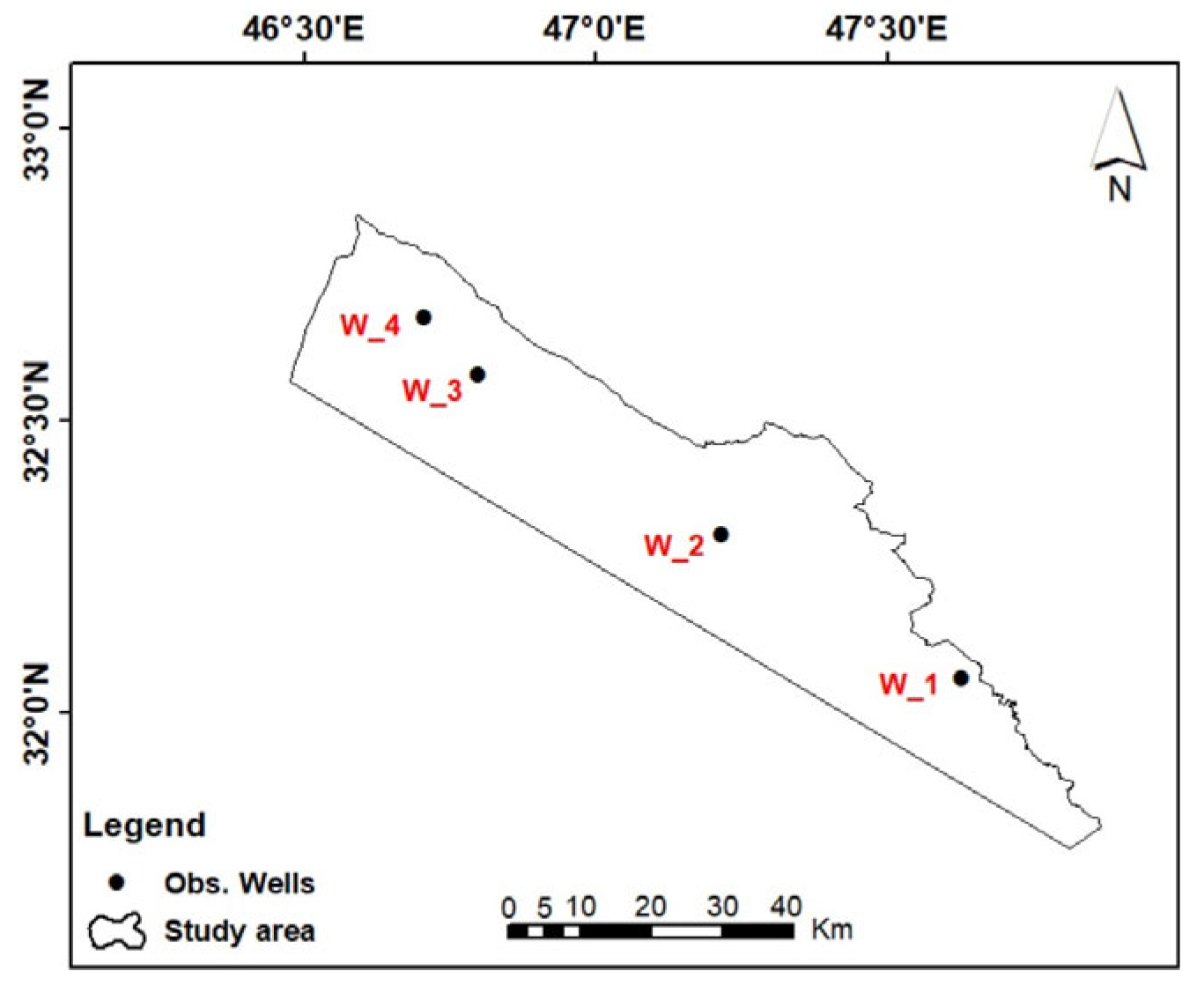

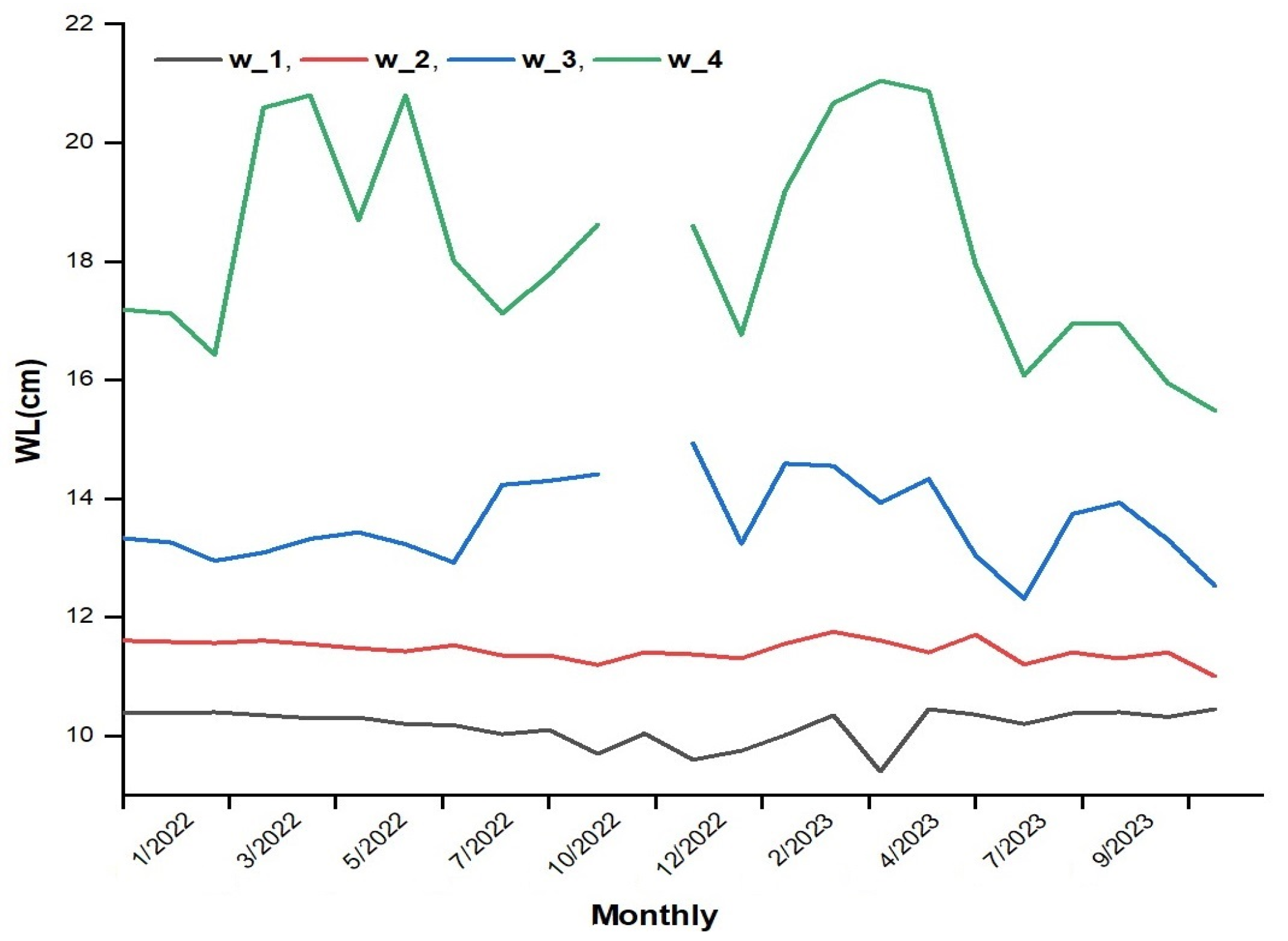
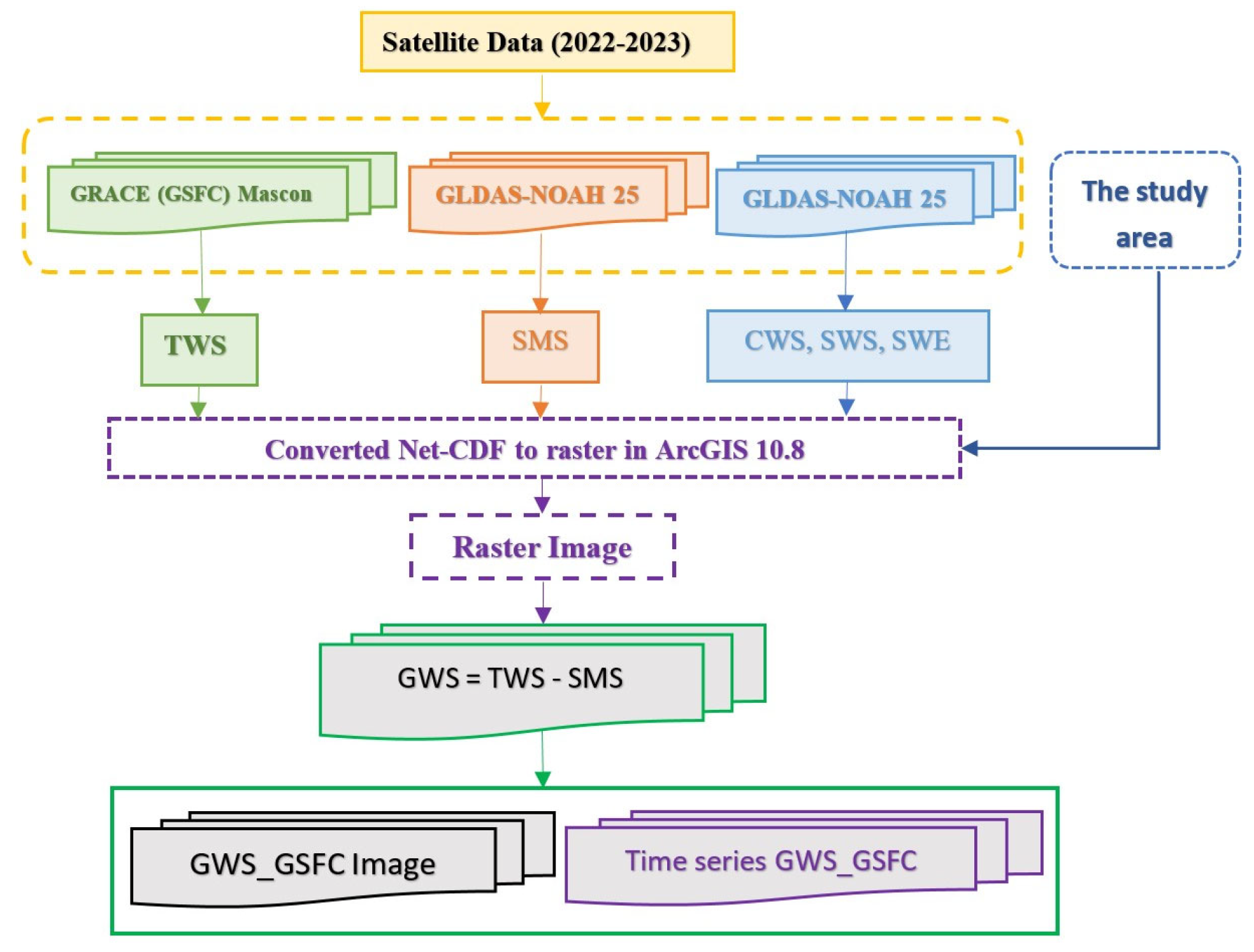
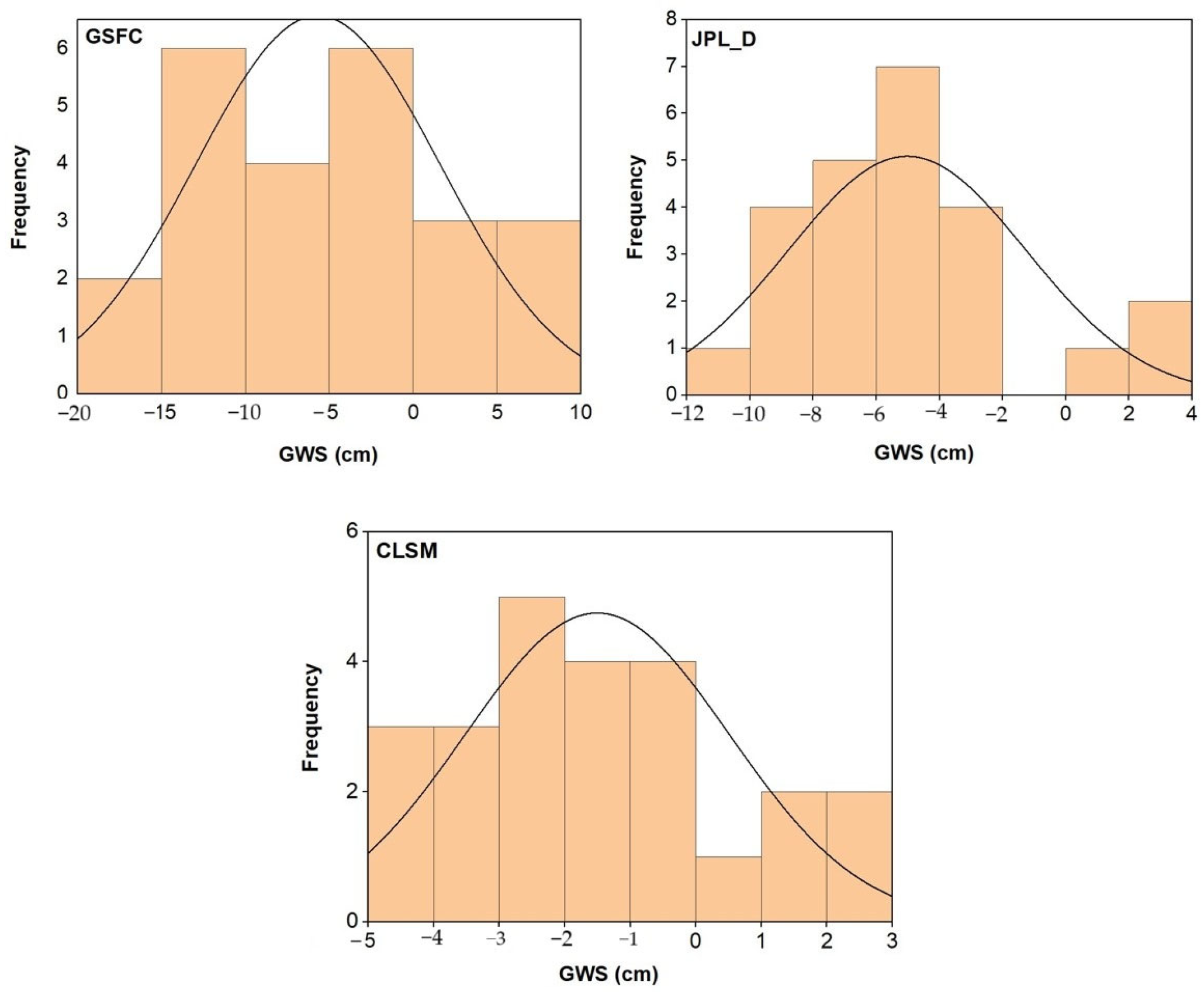
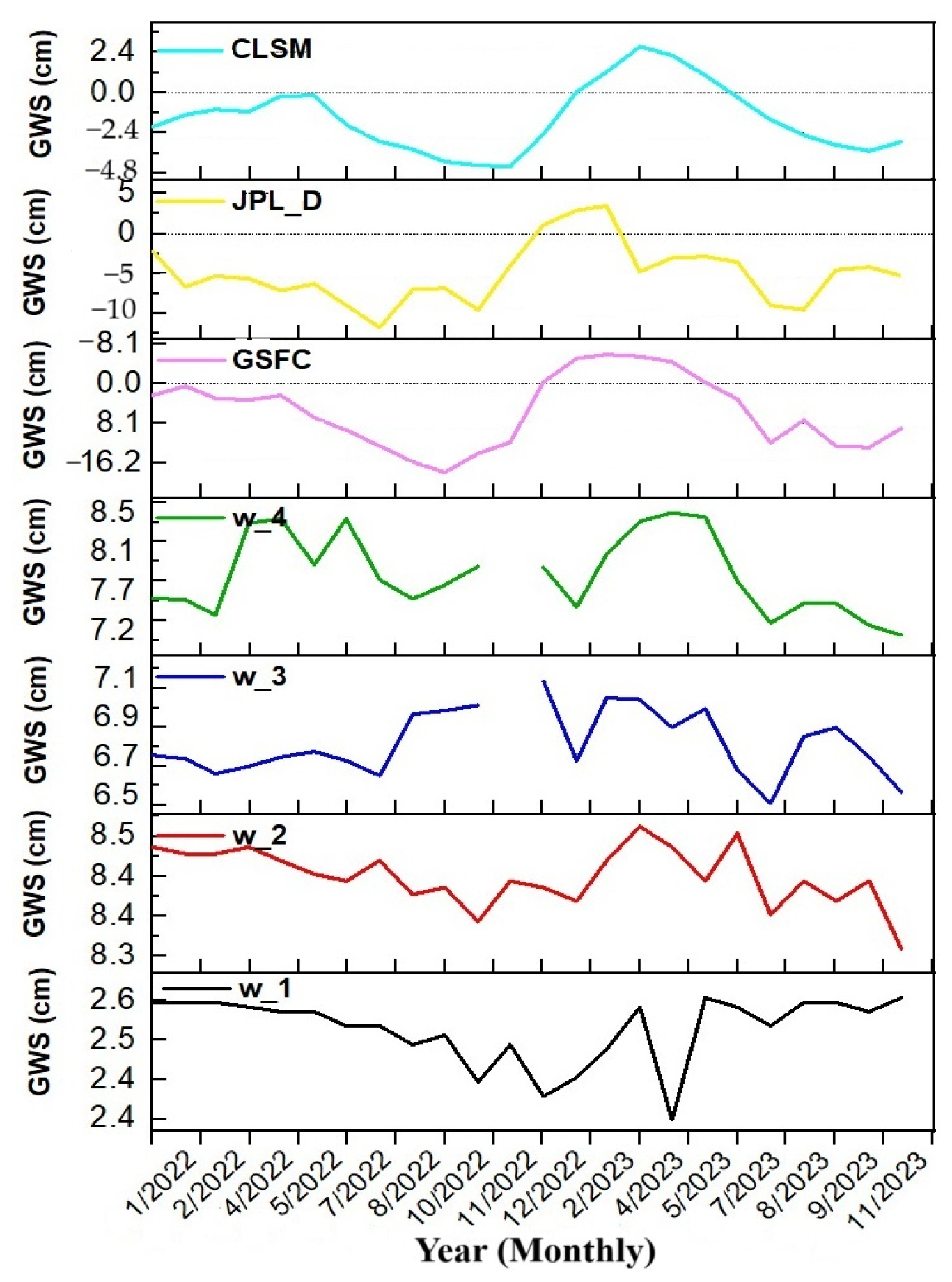

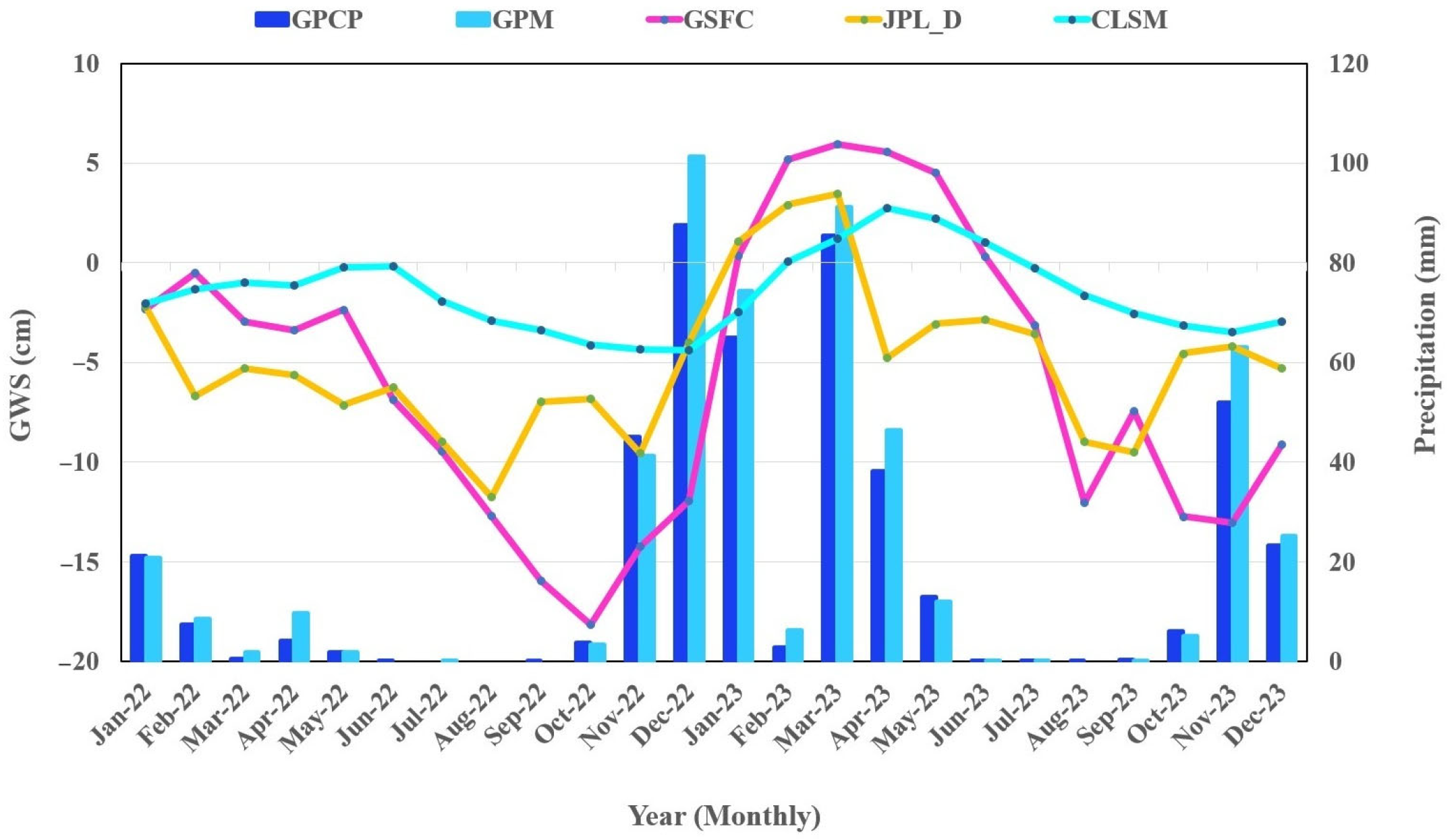
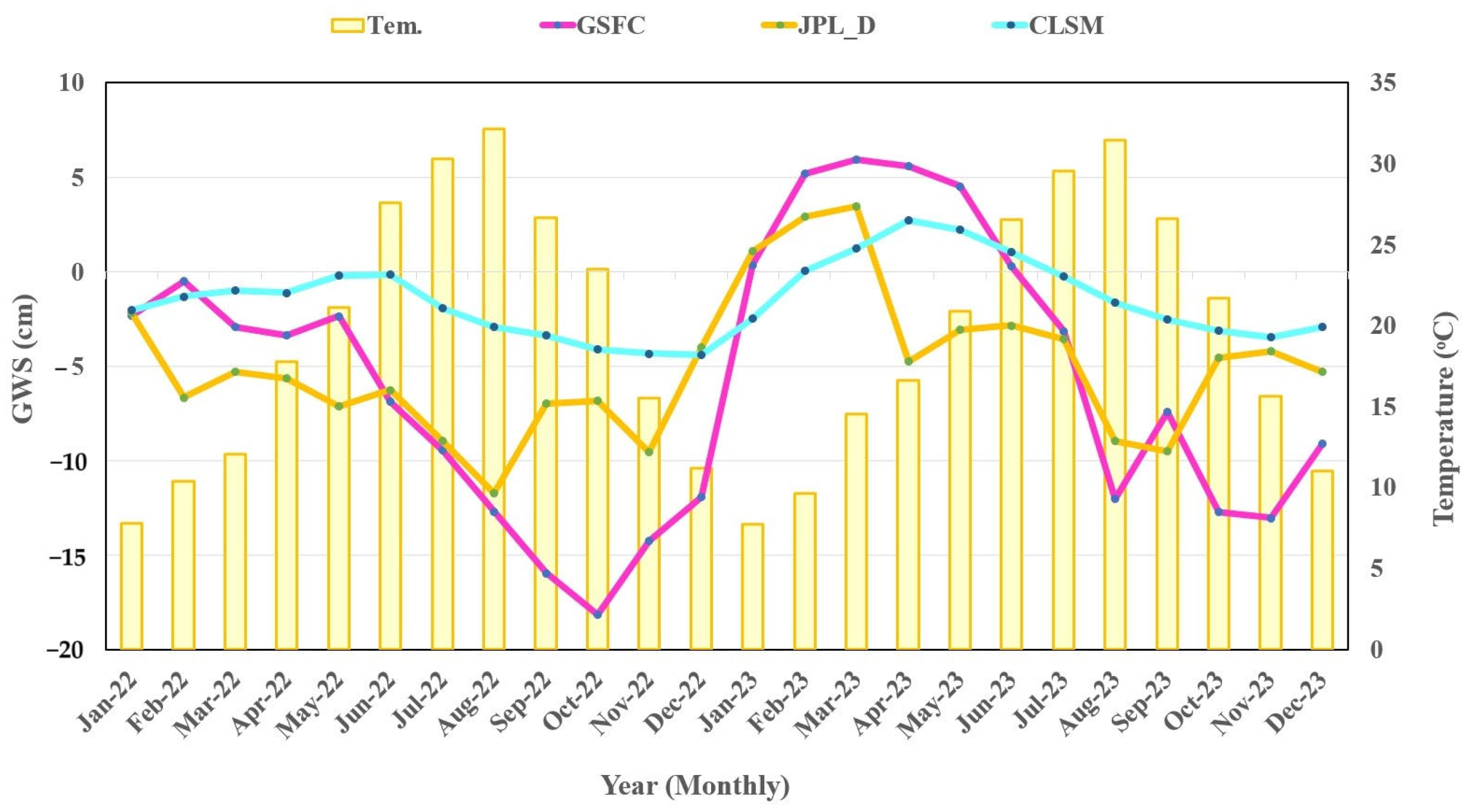

| No. Source | Data |
|---|---|
| 1 | Monitoring well in situ data. |
| 2 | GWS derived from GRACE data. |
| 3 | GWS from CLSM—GLDAS model. |
| 4 | GRACE monthly mass grids—global mascon (CRI Filtered) from GEE. |
| Variables | Data Type | Resolution |
|---|---|---|
| GSFC mascon | GSFC-RL06v02 | Jan 2022–Dec 2023 (Monthly) |
| SMS | GLDAS model NOAH025_Mv2.1 | Jan 2022–Dec 2023 (Monthly) |
| SWS, CWS | GLDAS model NOAH025_Mv2.1 | Jan 2022–Dec 2023 (Monthly) |
| GPM | GPM_3IMERGM v07 | Jan 2022–Dec 2023 (Monthly) |
| GPCP | GPCPMON v3.2 | Jan 2022–Dec 2023 (Monthly) |
| CLSM025 | DA1_D v2.2 | Jan 2022–Dec 2023 (daily) |
| Well data | Point data | Jan 2022–Dec 2023 (Monthly) |
| ET | Point data | Jan 2022–Dec 2023 (Monthly) |
| Parameters | GWS_GSFC | GWS_JPL_D | GWS_CLSM |
|---|---|---|---|
| Minimum (cm) | −18.14 | −11.74 | −4.40 |
| Maximum (cm) | 5.94 | 3.45 | 2.74 |
| Mean (cm) | −5.68 | −5.02 | −1.50 |
| Standard Deviation | 7.29 | 3.76 | 2.02 |
| Skewness | 0.08 | 0.62 | 0.46 |
| Kurtosis | −1.14 | 0.51 | −0.51 |
| Parameters | GWS_GSFC | GWS_JPL_D | GWS_CLSM |
|---|---|---|---|
| Pearson correlation | −0.70 | −0.50 | 0.20 |
| Spearman correlation | −0.50 | −0.11 | 0.40 |
| Kendall correlation | −0.35 | −0.10 | 0.30 |
Disclaimer/Publisher’s Note: The statements, opinions and data contained in all publications are solely those of the individual author(s) and contributor(s) and not of MDPI and/or the editor(s). MDPI and/or the editor(s) disclaim responsibility for any injury to people or property resulting from any ideas, methods, instructions or products referred to in the content. |
© 2025 by the authors. Licensee MDPI, Basel, Switzerland. This article is an open access article distributed under the terms and conditions of the Creative Commons Attribution (CC BY) license (https://creativecommons.org/licenses/by/4.0/).
Share and Cite
Mohammed, H.K.; Al-Khafaji, M.S.; Alwan, I.A. Analysis of Groundwater Storage at The Local Scale in the Missan Region, Iraq, Based on GRACE Satellite and Well Data. Geosciences 2025, 15, 91. https://doi.org/10.3390/geosciences15030091
Mohammed HK, Al-Khafaji MS, Alwan IA. Analysis of Groundwater Storage at The Local Scale in the Missan Region, Iraq, Based on GRACE Satellite and Well Data. Geosciences. 2025; 15(3):91. https://doi.org/10.3390/geosciences15030091
Chicago/Turabian StyleMohammed, Hanan K., Mahmoud S. Al-Khafaji, and Imzahim A. Alwan. 2025. "Analysis of Groundwater Storage at The Local Scale in the Missan Region, Iraq, Based on GRACE Satellite and Well Data" Geosciences 15, no. 3: 91. https://doi.org/10.3390/geosciences15030091
APA StyleMohammed, H. K., Al-Khafaji, M. S., & Alwan, I. A. (2025). Analysis of Groundwater Storage at The Local Scale in the Missan Region, Iraq, Based on GRACE Satellite and Well Data. Geosciences, 15(3), 91. https://doi.org/10.3390/geosciences15030091








